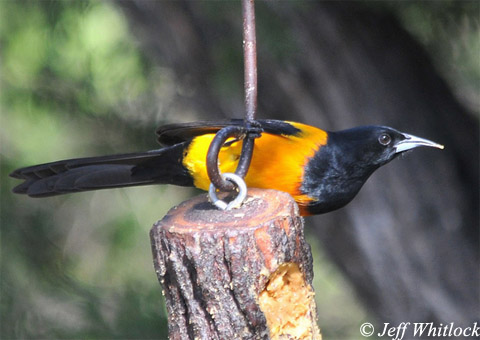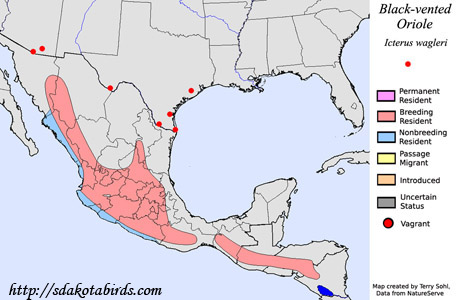| Length: 8.5 inches | Wingspan: 13 1/2 inches | Seasonality: Non-resident in South Dakota |
| ID Keys: (males) Black head, back, tail, undertail, and upper chest. Orange body. | ||
 The
Black-vented Oriole is a bird of open forested lands of Mexico and Central
America. It was unknown in the United States until a single bird was found
in Big Bend National Park in 1968. Since that time, the species has
been found on occasion in both southern Texas and in far southeastern
Mexico. Breeding evidence has been found in Texas.
The
Black-vented Oriole is a bird of open forested lands of Mexico and Central
America. It was unknown in the United States until a single bird was found
in Big Bend National Park in 1968. Since that time, the species has
been found on occasion in both southern Texas and in far southeastern
Mexico. Breeding evidence has been found in Texas.
Habitat: Normal habitat includes semi-arid, open forest lands and scrubland with scattered trees. They are typically found in lowlands or rather low on mountainous slopes.
Diet: Feeds heavily on insects and spiders, but will also eat fruits, berries, seeds, and nectar.
Behavior: Usually nests in low- to mid-elevations in the forest canopy. Foraging may done anywhere from near ground level to high in the forest canopy.
Nesting: The nest of a Black-vented Oriole is placed low in a tree or in forest understory, and is made of various plant fibers. A clutch consists of 2 to 5 eggs, and the female alone incubates them.
Song: Males sing loud, squeaky warbling.
Migration: Considered a permanent resident throughout its range, some short distance seasonal migration is noted.
Feeders: May attend feeders for suet, fruits, jellies, and nectar.
Interactive eBird Map: Click here to access an interactive eBird map of Black-vented Oriole sightings
Similar Species: In range, most likely to be confused with Scott's Oriole.
Conservation Status: Populations are considered stable, and the IUCN lists the Black-vented Oriole as a species of "Least Concern"
Further Information: 1) BirdLife International - Black-vented Oriole
2) WhatBird - Black-vented Oriole
3) Audubon Guide - Black-vented Oriole
Photo Information: Photo taken by Jeff Whitlock. Photo licensed under Creative Commons Attribution-NonCommercial-ShareAlike 2.0 Generic License
| Click below for a higher-resolution map |
 |
| South Dakota Status: Non-resident in South Dakota |
Additional Black-vented Oriole Photos (Coming soon...)
